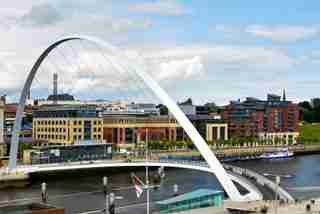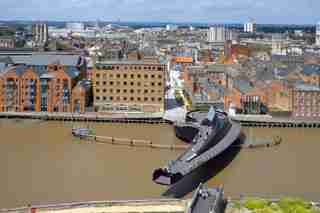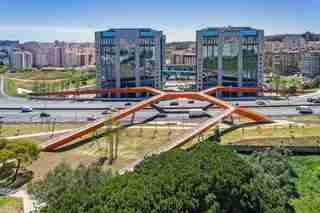Pedestrians and bikers are accustomed to sharing the road and battling automotive traffic, but this proposition becomes trickier, and often more dangerous, when it comes to crossing a major thoroughfare or body of water. A pedestrian bridge , also known as a footbridge, provides a safe mode of passage for cyclists and walkers, and often enriches the area. A successful design must be a safe mode of transit for pedestrians that doesn't interfere with other traffic on roads or waterways. Architects and artists have conceived spectacular overpasses that are marvels of both design and engineering . In fact, many of these smaller passages have designs that can rival larger bridges built for cars and trucks. From a bright orange overpass in Portugal to a nearly invisible bridge that goes through a moat in the Netherlands , these structures are sure to make drivers jealous.

Gateshead Millennium Bridge
Where: England Completed: 2001 Designer: Wilkinson Eyre
Architecture firm Wilkinson Eyre devised the curved bridge across the River Tyne. The structure, which connects Gateshead Quays and Newcastle’s north bank, tilts like a blinking eye to allow ships to pass underneath.

Scale Lane Bridge
Where: Hull, England Completed: 2013 Designer: McDowell+Benedetti
With a shape reminiscent of an apostrophe, the Scale Lane Bridge provides a unique mode of transport across the River Hull. Pedestrians are able to ride on the swing bridge as it opens to accommodate river traffic. Designed by the architecture firm McDowell+Benedetti, the black steel structure features an installation by artist Nayan Kulkarni, which also serves as an alert when the bridge is in motion.

Ponte Segunda Circular
Where: Lisbon, Portugal Completed: 2015 Designer: MXT Studio
Designed by Maximina Almeida and Telmo Cruz of MXT Studio, this footbridge stretches across the Second Circular Road in Lisbon and creates a network of connections for pedestrians and cyclists. The distinctive orange passage is constructed of steel, and the arrangement of the spans was inspired by the farm paths that used to crisscross the local landscape.
Peace Bridge
Where: Calgary, Alberta Completed: 2012 Designer: Santiago Calatrava
Architect Santiago Calatrava’s Peace Bridge spans the Bow River in Calgary, connecting a residential community with the downtown area. The partially enclosed helical structure features a central bike lane with pedestrian paths on either side and is painted red and white, colors that also appear in the Canadian and Calgary flags.
The Jetty to Mont-Saint-Michel
Where: Mont-Saint-Michel, France Completed: 2014 Designer: Dietmar Feichtinger Architectes
Dietmar Feichtinger Architectes designed this passage to the medieval French city of Mont-Saint-Michel, located off the coast of Normandy. Linking the mainland to the UNESCO World Heritage Site, the structure includes the nearly half-mile-long pedestrian bridge and a slightly longer causeway used for shuttles.
The Luchtsingel
Where: Rotterdam, Netherlands Completed: 2015 Designer: ZUS
Connecting the north and center districts of Rotterdam in the Netherlands, the Luchtsingel was designed to stimulate development and economic growth in areas that had become neglected. The quarter-mile-long pedestrian bridge, devised by the Dutch architecture firm ZUS, was financed by the city and a crowdfunding campaign. The wooden structure is lined with planks bearing the names of the sponsors.
Merchant Square Footbridge
Where: London Completed: 2014 Designer: Knight Architects
Knight Architects designed the cantilevered bridge across the Grand Union Canal in London. The deck is formed of five steel beams, which are raised in a motion resembling the unfolding of a Japanese fan.
Butterfly Bridge
Where: Copenhagen Completed: 2015 Designer: Dietmar Feichtinger Architectes
Designed by Dietmar Feichtinger Architectes, Copenhagen’s Butterfly Bridge consists of three segments connecting the banks of the Christianshavns Kanal. Two of the steel spans can be raised independently or together, forming the shape of a butterfly.
Melkwegbridge
Where: Purmerend, Netherlands Completed: 2006 Designer: NEXT Architects
Located in the city of Purmerend and designed by NEXT Architects, the Melkwegbridge separates pedestrians and cyclists on two levels. An archway of steps curves above the lower deck, which can split to accommodate boats traveling on the Noordhollandsch Kanaal.
Webb Bridge
Where: Melbourne, Australia Completed: 2003 Designer: Denton Corker Marshall and Robert Owen
Architecture firm Denton Corker Marshall collaborated with artist Robert Owen on the design of the Webb Bridge in Melbourne’s Docklands precinct. The new ramped, steel-lattice structure links a decommissioned railway bridge to the south bank of the Yarra River, providing access for pedestrians and cyclists.
Cirkelbroen
Where: Copenhagen Completed: 2105 Designer: Olafur Eliasson
Inspired by the form of a series of ships moored next to each other, artist Olafur Eliasson’s Cirkelbroen spans Copenhagen’s Christianshavns Kanal. Five circular platforms—each with a “mast”—are joined to create the 129-foot-long pedestrian and cyclist passage, which was completed in 2015.
Pedro e Inês Footbridge
Where: Coimbra, Portugal Completed: 2007 Designer: Balmond Studio
With its lightning-bolt shape, the Pedro e Inês footbridge in Coimbra appears to stop in midair. The 900-foot expanse was designed by Balmond Studio and features a balustrade of colorful glass. The bridge’s name—and the inspiration for its design—comes from a pair of star-crossed Portuguese lovers from the 14th century.
Moses Bridge
Where: Halsteren, Netherlands Completed: 2011 Designer: RO&AD Architecten
Rather than crossing over a moat at Fort de Roovere in the Netherlands, the Moses Bridge goes through it. Constructed of wood, the RO&AD Architecten–built structure was designed to be invisible from a distance, blending into the water and the surrounding landscape.
BP Pedestrian Bridge
Where: Chicago Completed: 2004 Designer: SOM and Gehry Partners
Frank Gehry’s snakelike BP Pedestrian Bridge connects Chicago’s Maggie Daley Park with Millennium Park, home to the Jay Pritzker Pavilion, another Gehry design. Constructed in collaboration with SOM, the bridge is clad in panels of brushed stainless steel and also serves as a sound barrier, reducing noise from Columbus Drive below.
Millennium Bridge
Where: London Completed: 2000 Designer: Foster + Partners, Anthony Caro, and Arup
London’s Millennium Bridge spans the Thames, connecting St. Paul’s Cathedral with the Tate Modern and Globe Theater. Designed by Foster + Partners in collaboration with sculptor Anthony Caro and engineering firm Arup, the bridge opened in 2000 but was temporarily closed due to unexpected swaying. Dampers were added to control the movement created by the synchronized footfall of pedestrians.
The Paleisbrug
Where: 's-Hertogenbosch, the Netherlands Completed: 2015 Designer: Benthem Crouwel Architects
Connecting the historic city center of 's-Hertogenbosch and the newly developed area of Paleiskwartier, the Paleisbrug is a raised park and pedestrian and cycle bridge all in one. Benthem Crouwel Architects outfitted the weatherproof steel structure with a solar collector to help power the surrounding area. Landscape architect Piet Oudolf planned the flower beds and tree planters, adding low plants to preserve the views.
Nelson Street Cycleway
Where: Auckland, New Zealand Completed: 2015 Designer: Monk Mackenzie Architects, LandLAB, and Katz Maihi
The Nelson Street Cycleway, also known as LightpathAKL, was created using nearly 2,000 feet of former highway. Monk Mackenzie Architects and LandLAB resurfaced the space in a bright pink and added 300 programmable LED light boxes to the passage, which is shared by pedestrians and cyclists. Works by Maori artist Katz Maihi were engraved into aluminum plates and incorporated into western edge.
La Roche-sur-Yon Pedestrian Bridge
Where: La Roche-sur-Yon, France Completed: 2010 Designer: Bernard Tschumi Architects and Hugh Dutton & Associés
Architects Bernard Tschumi and Hugh Dutton collaborated on the vibrant passage over the tracks of the TGV railway, which connects new neighborhoods with the historic city and replaces a standard railway bridge. The bold tubular bridge features a triangulated mesh exterior, which serves as an eye-catching structural element. The walkway is nearly 220 feet long and was built using 130 tons of steel.
